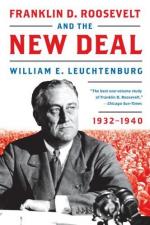
|
| Name: _________________________ | Period: ___________________ |
This test consists of 15 multiple choice questions and 5 short answer questions.
Multiple Choice Questions
1. When asked why he kept a family going on credit, a Philadelphia storekeeper told a reporter that there were how many children in the family's house with no shoes?
(a) 5.
(b) 11.
(c) 8.
(d) 15.
2. When discussing his time as Governor, Leuchtenburg says that Roosevelt accomplishes gains in all but which of the following areas?
(a) Unemployment relief.
(b) Industrial welfare.
(c) Immigration reform.
(d) Conservation.
3. Which of the following politicians is from Massachusetts and laments that the creation of the Tennessee Valley Authority is a "Soviet dream" in 1933?
(a) Hugo Black.
(b) James Warburg.
(c) George Norris.
(d) Joe Martin.
4. In which of the following cities does the American Federation of Labor hold its 1934 convention?
(a) Atlanta.
(b) New York.
(c) San Francisco.
(d) Des Moines.
5. In "One Third of a Nation" Congress approves the Emergency Relief Appropriation Act. In which year does this act pass?
(a) 1933.
(b) 1935.
(c) 1934.
(d) 1936.
6. Just prior to the passage of the Rural Electrification Administration in May of 1935, for every 10 American farms how many are without electricity?
(a) 2.
(b) 4.
(c) 9.
(d) 10.
7. According to "Winter of Despair," which of the following individuals works for The New York Times and first coins the phrase "brain trust" in reference to Roosevelt's advisers?
(a) Basil O'Connor.
(b) James Kieran.
(c) Samuel Rosenman.
(d) Raymond Moley.
8. When discussing Senator Huey Long of Louisiana, Leuchtenburg mentions that Long loves his nickname of what?
(a) Shark.
(b) Kingfish.
(c) Dewey.
(d) Amos.
9. In the summer of 1932, farmers riot in all but which of the following states?
(a) Wisconsin.
(b) Georgia.
(c) Iowa.
(d) Nebraska.
10. "Winter of Despair" mentions all but which of the following individuals as progressives who oppose deficit spending?
(a) Robert La Follette.
(b) Fiorello La Guardia.
(c) Bernard Baruch.
(d) Robert Wagner.
11. By which of the following months in 1934 has Roosevelt grown tired of the new head of the Recovery Administration and secured that person's resignation?
(a) February.
(b) September.
(c) April.
(d) July.
12. According to "The Politics of Hard Times," about how many people were unemployed by 1932?
(a) 800 thousand.
(b) 13 million.
(c) 5 million.
(d) 125 thousand.
13. Justice Louis Brandeis tells Roosevelt in 1935 that he must return to regulated competition, the "little unit." To which other president had Brandeis given this advice?
(a) Woodrow Wilson.
(b) Warren G. Harding.
(c) Calvin Coolidge.
(d) Herbert Hoover.
14. As "Over the Top" concludes, Leuchtenburg reports that by the spring of 1934 there were twice as many men working as the year before in which city?
(a) Detroit.
(b) New York.
(c) Des Moines.
(d) St. Louis.
15. As "One Third of a Nation" closes, Harry Hopkins writes that even if prosperity returns to America at least how many will still be unemployed?
(a) 200 thousand.
(b) 12 million.
(c) 600 thousand.
(d) 5 million.
Short Answer Questions
1. As "Over the Top" opens, Roosevelt appoints which of the following individuals to head the Recovery Administration?
2. According to "Winter of Despair," which of the following words appears most frequently in the writings of New Deal theorists?
3. Which of the following new taxes does Roosevelt not propose to Congress in June of 1935?
4. As "The Second Hundred Days" opens, New Dealers worry that all but which of the following conservative Supreme Court justices might deem the New Deal unconstitutional?
5. By the end of 1934, how much money has the government spent on relief for the unemployed?
|
This section contains 516 words (approx. 2 pages at 300 words per page) |

|




